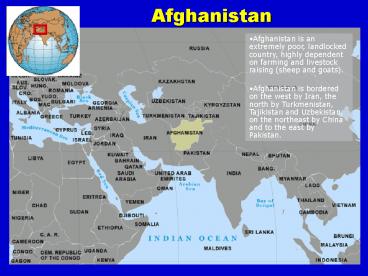Afghanistan - PowerPoint PPT Presentation
1 / 6
Title:
Afghanistan
Description:
... forces supplied and trained by the US, Saudi Arabia, Pakistan, and others. Fighting continued among the various mujahidin factions, but the fundamentalist ... – PowerPoint PPT presentation
Number of Views:43
Avg rating:3.0/5.0
Title: Afghanistan
1
Afghanistan
- Afghanistan is an extremely poor, landlocked
country, highly dependent on farming and
livestock raising (sheep and goats). - Afghanistan is bordered on the west by Iran, the
north by Turkmenistan, Tajikistan and Uzbekistan,
on the northeast by China and to the east by
Pakistan.
2
Background
- Afghanistan was invaded and occupied by the
Soviet Union in 1979. - The USSR was forced to withdraw 10 years later by
anti-communist mujahidin forces supplied and
trained by the US, Saudi Arabia, Pakistan, and
others. - Fighting continued among the various mujahidin
factions, but the fundamentalist Islamic Taliban
movement has been able to seize most of the
country. - In addition to the continuing civil strife, the
country suffers from enormous poverty, a
crumbling infrastructure (roads, schools,
hospitals), and widespread live mines (weapon
that explodes when stepped on). - International aid can deal with only a fraction
of the humanitarian problem. - Afghanistan was by far the largest producer of
opium poppies in 1999, and narcotics trafficking
is a major source of revenue.
3
Afghanistans Topography
4
Afghanistans Topography
- Afghanistan, a country about the size of Texas,
boasts elevations to more than 24,000 feet. Its
rugged topography has both physical and cultural
implications, critical to understanding why the
country has never been totally conquered. One of
the world's most rugged mountain chains, the
Hindu Kush, extends from the Pamir Knot into the
country. - These rugged mountains, alternating high ridges
and deep valleys create a topography, or lay of
the land, unequaled in North America. It is
partly because of the isolation of these valleys
that cultural distinctiveness is so prevalent
across Afghanistan. - This topography makes modern land transportation
very, very difficult. - Throughout history, Afghanistan's valley
population often has taken to the mountains,
where they have built rudimentary fortifications
to wait out or repel invaders. They often used
natural limestone cavessimilar to those shown as
Osama bin Laden's headquarters. But there are
other more unconventional hiding places, as well.
- For example, at the foot of mountain valleys
across the region, systems of hand-dug shafts and
tunnels called qanats (kah-NOTs) provide
irrigation. A qanat consists of a shaft that
penetrates to naturally stored groundwater found
in delta-like features at the base of mountains.
In arid climates, runoff from infrequent rain
spills out of the mountains and percolates
through sand and gravel that has been deposited
by water. These landform features, occurring
wherever intermittent streams flow out onto the
valley floors are called alluvial fans. - Villages are often situated on the alluvial fans
to take advantage of scarce groundwater.
Virtually all villages in such locations across
have qanats, which are cleaned regularly of silt
and sand, so that water may be lifted or pumped,
or flow out to irrigated crops along alluvial
fan's margins. - During the Soviet invasion, as well as others
down through history, the interlaced shafts and
tunnels of qanats provided temporary hiding
places for local villagers, particularly women
and children. In fact, a favorite Soviet military
tactic was to pour diesel fuel into these qanats
and ignite it in an effort to eliminate them as
hiding places. When the Western press learned of
this barbaric tactic, the practice was condemned
widely. Nonetheless, qanats offer a multitude of
hiding and storage places all across the country.
- Geography in the News. September 28, 2001. 592.
5
Afghanistans Civil War
6
Afghan Refugees
- Afghans remain the largest, single refugee group
in the world, a result of more than 10 years of
fighting with the Soviet Union - More than 3.5 million refugees reside in Pakistan
and Iran alone.































